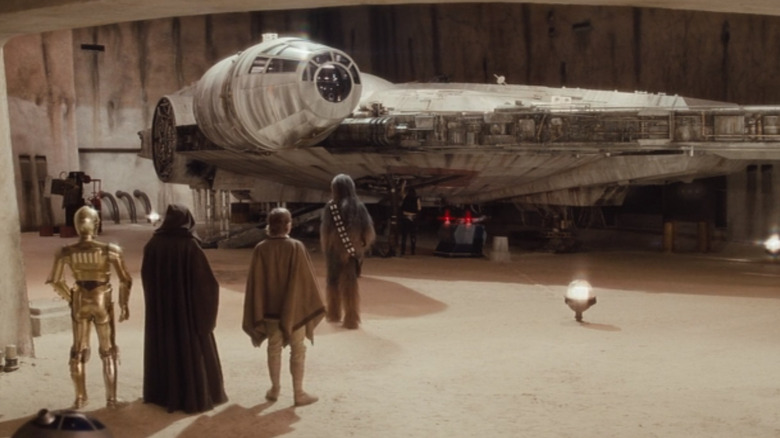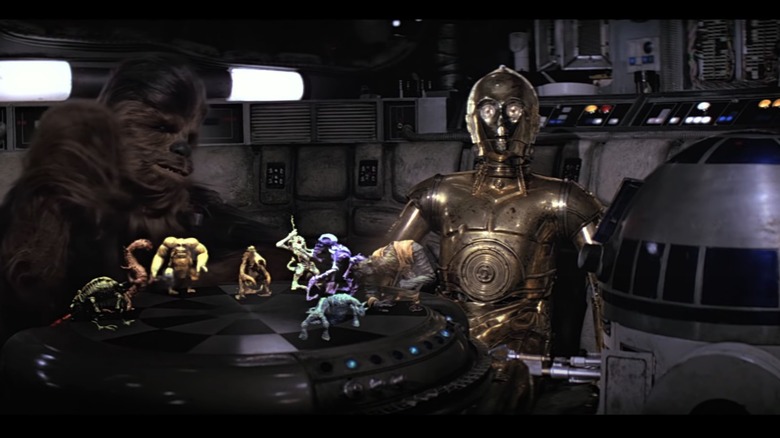Roger Christian Created Star Wars' Iconic Set $100,000 Under Budget
Whether you are a fan of "Star Wars" or not, it's undeniable that the franchise had an indelible effect, not just on cinema or pop culture, but on the world at large. The influences of "Star Wars" can be seen in such varied fields of technology, business, economics, and even politics. George Lucas' 1977 film sparked changes in the movie and television landscape, from how special effects were done and how merchandising happened (via Time) to inspiring a generation of filmmakers and fans (via Vanity Fair).
Many movies, books, comics, and television shows — like "Andor" — continue expanding the universe for today's audience, and the new and continuing projects prove the "Star Wars" franchise still has stories to tell. Plus, many of the details regarding what went into creating the original have practically passed into Hollywood legend, from Carrie Fisher's stories about how George Lucas wouldn't let her wear a bra during filming (via YouTube) to the use of animal noises to create sounds for Chewbacca, Tusken Raiders, and ships like the TIE fighters (via Seeker).
Here's one story you may not know, though: set designer Roger Christian, who is credited for much of the grimy Western feel of the original "Star Wars," created the Millennium Falcon for a cost that was way under budget.
The Millennium Falcon set was made up of airplane scrap parts
Roger Christian is responsible for that beaten-down and weathered look of the first "Star Wars." According to his account on Star Wars Insider, George Lucas was looking for talent for his new film, but Christian didn't like the new, sleek look of the fake worlds that dominated science fiction. "I told him that I saw the future like an old car that's bruised and damaged, but it just keeps going and is constantly repaired," he said. He was immediately hired.
In fact, the Millennium Falcon ended up being the first set he ever did. To move away from that shiny, beautiful look, Christian started researching submarines and cockpits of B-52 bombers. He figured actual airplane scrap could be layered onto the sets — and it was not expensive at all.
He found himself going to London airfields and buying up all the airplane junk he could take. It was all sold by weight, he said in an interview with Tom Power, and he could purchase huge amounts of the light metal for just 50 British pounds. Christian ended up buying several trailer loads' worth (via YouTube). After that, it was simply a matter of breaking down that scrap and incorporating it into the ship he was creating. As Christian explained, "I spent $100,000 under my little budget, because no one wanted this scrap. But it was cheap as chips, and that was the core of the design of 'Star Wars.'"
The technique was part of Christian's desire to connect audiences with sci-fi
The $100,000 saved thanks to Roger Christian's frugal set building was probably quite a welcome one for George Lucas, given that the film had just a $11 million budget overall (via Vanity Fair). And it was this lack of a budget that also resulted in Christian using found objects to make up much of the universe you see in "Star Wars." Given that he felt shiny, new sci-fi worlds never connected with audiences, making do with that he could get worked well for the aesthetic Christian was looking to create.
Christian explained that after finishing the Millennium Falcon cockpit and the hold where Chewbacca plays a holographic chess game, he felt things were coming together in a special way. "Those were my gamble because I couldn't afford to dress the sets in a normal way ... but when I saw those two sets, I knew," he said.
For Christian, the design helped audiences develop a more emotional attachment to the story. Eschewing what he called "guns that go beep and don't work and overdesigned sets," Christian felt that Lucas' adherence to the hero's story and the lack of a clinical space environment — as seen in previous sci-fi films — were key. "It's a kind of world that we can identify with," Christian said (via TheForce.net.) "And I think that's why there was this huge interest and fan base that wanted to know everything about this."


